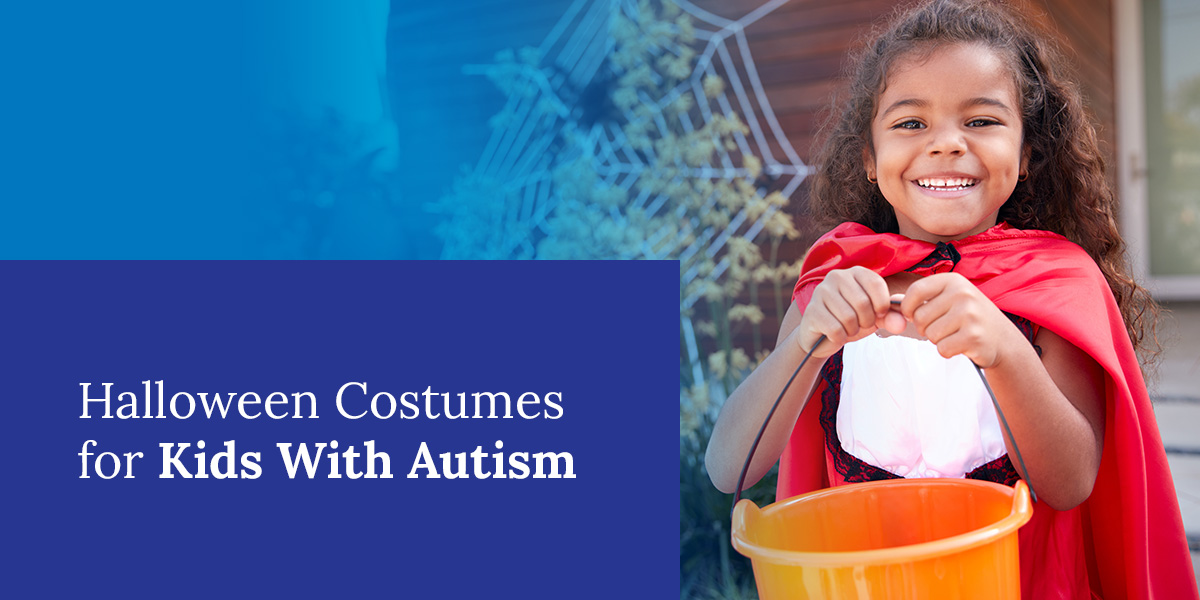Halloween is an exciting time for kids of all ages — and children with Autism Spectrum Disorder (ASD) deserve to have all the fun, too. However, your child with autism may have sensory issues that affect their ability to wear certain types of costumes. Thankfully, workarounds for these issues allow your child to participate in Halloween festivities comfortably.
What Are Sensory Issues in ASD?
Many people have sensory issues, including those with and without ASD. Autism often greatly influences sensory processing. Sensory processing issues can be related to tastes, sounds, smells, sights and touch or feeling. These issues can present in numerous ways, including:
- Under- or overreaction to pain.
- Overwhelmed by crowds.
- Sensitivity to specific smells.
- Distress over visually busy or high-noise environments.
Halloween can present several challenges to children with sensory processing issues, particularly when it comes to costumes. Coming up with fun and unique outfits to let your child dress up in a way that suits them best is essential to having a fun holiday.
8 Sensory-Friendly Halloween Costume Ideas for Kids With Autism
When you think of a Halloween costume, you may imagine cheap wigs or uncomfortable materials with arm holes that don’t fit quite right. If those things would bother you, they would likely bother a child with ASD and sensory issues.
Since many store-bought costumes are built this way, it’s a good idea to come up with other plans to help your child dress up. Examples of sensory-friendly Halloween costumes include:
1. Adaptive Store-Bought Costumes
Several companies have invested in adaptive and inclusive costumes for children with ASD and other conditions. Many of these adaptive costumes are popular movie or TV characters or animals. They’re made with softer materials, no tags and detachable pieces. They also often have hidden openings and flat seams.
You can always try small businesses if your child doesn’t like the options you find at the box store. Many creators have invested in making sensory-friendly costumes and clothing a priority.
2. T-Shirt or Hoodie Costumes
While some children with ASD may not be into full-fledged costumes, there are still ways they can get in on the fun. Many stores sell T-shirts and hoodies designed to look like movie or video game characters, animals and more. Do some research into brands or stores that sell this type of clothing and let your child decide which one to choose.
3. Regular Clothes Into Costumes
Think about ways you could turn regular clothes into a costume. Does your child’s favorite character wear normal clothes, like jeans and a yellow checkered shirt? Or how about a green sweatshirt and sweatpants that you can tape triangles to so your child can be a dinosaur!
Taking clothes you know your child already enjoys — such as a comfortable T-shirt or their favorite jacket — and incorporating them into their Halloween costume can help create a more enjoyable experience.
4. Layers Upon Layers
If your child with autism wants to wear a costume with zippers, velcro or other uncomfortable features, try adding extra layers. Wearing soft clothes underneath the costume can create a buffer zone between the unfavorable features.
5. Do-It-Yourself (DIY) Costumes
Are you crafty? Can you sew? Whatever your skill level, there are numerous DIY options you could give your child for their Halloween costume this year.
For example, maybe your child’s favorite video game character wears a purple shirt with a unique neckline or holes and tears across it. If you have some scissors, you can cut the shirt as necessary. You could also get some fabric markers to draw specific designs.
If you can sew — depending on your skill level — you can make just about anything you want. You know your child best. Do they like loose-fitting clothes or something without noticeable seams? Modify their favorite character’s outfit to fit their needs as you put it together.
6. Standard Costumes — Adapted
Maybe your child wants to wear that store-bought costume after all. If it comes with a mask, wig or something else your kid is not a fan of, you can leave those parts out. Finding ways to adjust a costume your child likes can help make it more comfortable for them.
If you have experience with sewing and making alterations, you could also go that route. Adjusting your child’s costume goes a long way toward ensuring they have a pleasant experience during Halloween.
7. Pajamas to the Rescue
Your child with ASD might prefer wearing pajamas because they’re often softer. Luckily, many sets of kids’ pajamas resemble their favorite characters or have a holiday theme.
You could buy children’s Halloween-themed pajamas with ghosts, jack-o-lanterns and spiders prints. In other cases, you can find one- and two-piece sets resembling superhero costumes, animated characters or animals.
8. Halloween Accessories
Some children with autism may not be comfortable in any costume. Maybe they prefer their normal clothes or don’t want to wear one of the options you’ve presented. However, your kid may be able to handle Halloween-themed accessories.
Not all children will be into this idea, but you can always test it out. Ask them if they want a Halloween-themed hat, light bopper headbands or a necklace. Many stores sell these items, so try taking your child with you and let them pick out the ones they prefer.
Create a Spooky, Fun and Inclusive Halloween With These Adaptive for Autism Costume Ideas
Having fun on Halloween is an exciting experience for many children, including those on the spectrum. Providing your child with various inclusive options can help make the experience more pleasant.
At Spectrum of Hope, we want to encourage all children diagnosed with ASD and their family members to have a happy and fun holiday with these unique costume workarounds. If you have questions about sensory processing issues and autism, please reach out to our team today!


